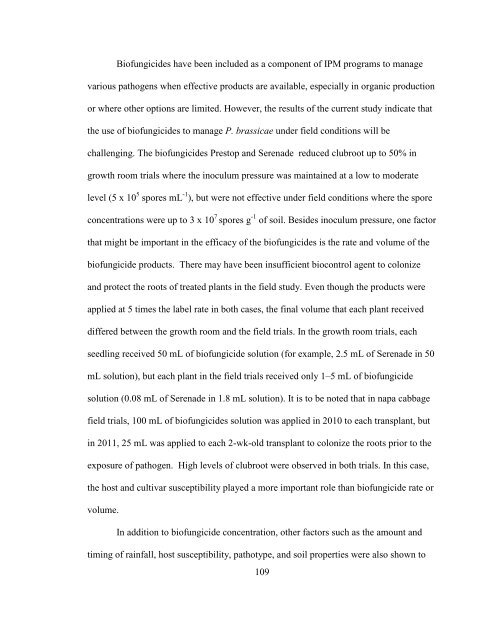Hema Kasinathan Thesis May 1 2012.pdf - Atrium - University of ...
Hema Kasinathan Thesis May 1 2012.pdf - Atrium - University of ...
Hema Kasinathan Thesis May 1 2012.pdf - Atrium - University of ...
Create successful ePaper yourself
Turn your PDF publications into a flip-book with our unique Google optimized e-Paper software.
Bi<strong>of</strong>ungicides have been included as a component <strong>of</strong> IPM programs to managevarious pathogens when effective products are available, especially in organic productionor where other options are limited. However, the results <strong>of</strong> the current study indicate thatthe use <strong>of</strong> bi<strong>of</strong>ungicides to manage P. brassicae under field conditions will bechallenging. The bi<strong>of</strong>ungicides Prestop and Serenade reduced clubroot up to 50% ingrowth room trials where the inoculum pressure was maintained at a low to moderatelevel (5 x 10 5 spores mL -1 ), but were not effective under field conditions where the sporeconcentrations were up to 3 x 10 7 spores g -1 <strong>of</strong> soil. Besides inoculum pressure, one factorthat might be important in the efficacy <strong>of</strong> the bi<strong>of</strong>ungicides is the rate and volume <strong>of</strong> thebi<strong>of</strong>ungicide products. There may have been insufficient biocontrol agent to colonizeand protect the roots <strong>of</strong> treated plants in the field study. Even though the products wereapplied at 5 times the label rate in both cases, the final volume that each plant receiveddiffered between the growth room and the field trials. In the growth room trials, eachseedling received 50 mL <strong>of</strong> bi<strong>of</strong>ungicide solution (for example, 2.5 mL <strong>of</strong> Serenade in 50mL solution), but each plant in the field trials received only 1–5 mL <strong>of</strong> bi<strong>of</strong>ungicidesolution (0.08 mL <strong>of</strong> Serenade in 1.8 mL solution). It is to be noted that in napa cabbagefield trials, 100 mL <strong>of</strong> bi<strong>of</strong>ungicides solution was applied in 2010 to each transplant, butin 2011, 25 mL was applied to each 2-wk-old transplant to colonize the roots prior to theexposure <strong>of</strong> pathogen. High levels <strong>of</strong> clubroot were observed in both trials. In this case,the host and cultivar susceptibility played a more important role than bi<strong>of</strong>ungicide rate orvolume.In addition to bi<strong>of</strong>ungicide concentration, other factors such as the amount andtiming <strong>of</strong> rainfall, host susceptibility, pathotype, and soil properties were also shown to109
















